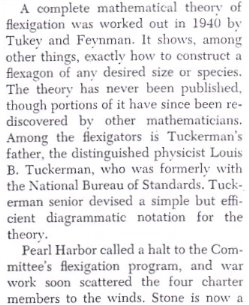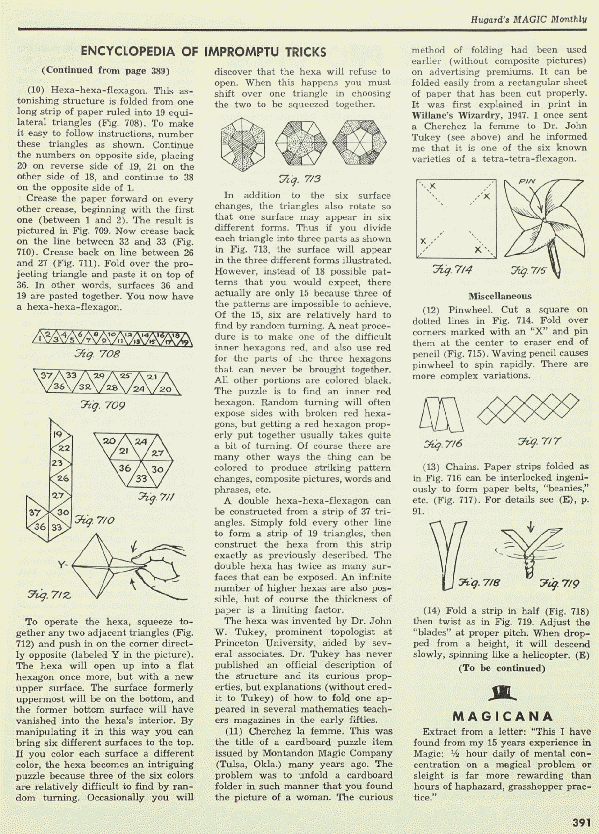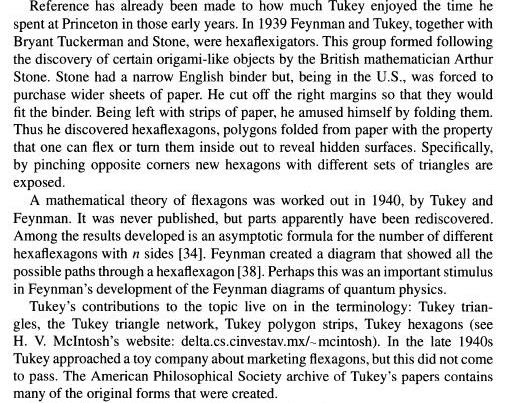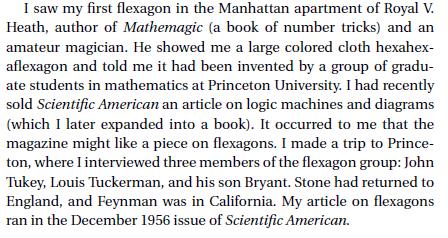| The Public Paperfolding History Project
x |
|||||||
| Hexaflexagons | |||||||
| This
page attempts to record what is known about the origin
and history of Hexaflexagons. Please contact me if you
know any of this information is incorrect, if you have
any other information that should be added or are able to
supply a copy of any of the articles referred to which I
have not seen. Thank you. ********** Fall 1939 - The Discovery of Hexaflexagons According to an article titled 'Flexagons', written by Martin Gardner, which was published in issue 195 of Scientific American in Dec 1956, Arthur Stone discovered hexaflexagons, specifically the trihexaflexagon and hexahexaflexagon, when playing with inch wide strips of paper. With the help of friends Bryant Tuckerman, Richard Feynman and John Tukey (who together with Stone formed the 'Flexagon Committee') many other hexaflexagons were quickly discovered and analysed:
It seems clear that the word 'flexagon' in this article refers only to hexaflexagons not to other varieties. In 'A Conversation with Martin Gardner', a record of an interview conducted by Anthony Barcellos, which was published in The Two-Year College Mathematics Journal of Sept 1979, Vol. 10, No. 4, pp. 233-244, Martin Gardner gives the source of his information for this article as John Tukey and Bryant Tuckerman. 'I had sold them one previous article on logic machines, so I queried them about this second piece, explained what a flexagon was, and they said, "Go ahead." So I made a trip to Princeton and interviewed John Tukey and Bryant Tuckerman.' 1951 An article in Mathematics Teacher 44 No 4 of April 1951 titled 'Devices for a Mathematics Laboratory' contained a section on 'Hexahexaflexagrams' contributed by Margaret Joseph . Despite its title it simply describes how to make a standard hexahexaflexagon. ********** 1952 An article titled 'A Six-sided Hexagon' by W R Ranson, describing a basic hexaflexagon, appeared in 'School Science and Mathematics' 52:94, of February 1952. ********** 1954 An article about hexaflexagons titled 'Note 2449 The Flexagon and the Hexahexaflexagram' by F G Maunsell was published in 'The Mathematical Gazette' 38 of September 1954. ********** 1955 According to Martin Gardner (see entry for 2008) in this year the Rust Engineering Company of Pittsburg used a hexaflexagon to advertise their service award banquet. ********** 1956 An article titled 'Flexagons', written by Martin Gardner, was published in issue 195 of Scientific American in Dec 1956. This article explained how to make and flex some basic straight strip hexaflexagons. It also stated that hexaflexagons had been invented in 1939 by Arthur Stone, then studying at Princeton, which were further developed by a 'Flexagon Committee' consisting of Stone himself, Bryant Tuckerman, Richard Feynman and John Tukey (all of whom were to go on to become famous in other ways) and that 'A complete mathematical theory of flexigation was worked out in 1940 by Tukey and Feynman.' There is no mention in the article of any flexagons other than hexaflexagons. According to the article 'Flexagons part one' in 'Xtra Credit 4' by Karl Fulves, published in 2009, the inspiration for this Martin Gardner article arose when 'Royal V Heath showed him a large coloured cloth hexahexaflexagon. Gardner interviewed the inventors.' ********** Hugard's Magic Monthly 13:9 of February 1956 contained an article in which Martin Gardner wrote about the hexahexaflexagon. Here he states that the 'hexa was invented by John W Tukey'. Information from Edwin Corrie.
********** 1957 The letters column of Scientific American Vol. 196, No. 3 of March 1957, pp. 8-20, contained several letters relating to flexagons, one of which, from Martin Gardner, gave a strip from which a heptahexaflexagon could be constructed, and the historical information that 'printed trihexas were used in October, 1955, to advertise the service award banquet of the Rust Engineering Company in Pittsburgh.' ********** Issue 64 of 'American Mathematical Monthly' contained an article titled 'Flexagons' by C O Oakley and R J Wisner which is a mathematical treatment of hexaflexagons. ********** Peter Messer provides a reference to a 'Note on Hexaflexagons (no 2672)' by J Crampin in 'The Mathematical Gazette' 41(335):55-56. I have not seen a copy of this note. ********** 'Paper Folding for the Maths Class', by D Johnson, published by the National Council of Teachers of Mathematics contains a description of how to make a basic hexaflexagon. ********** 'The Mathematical Gazette' Vol. 42, No. 339 of Feb 1958 contained an article about hexaflexagons written by Roger F. Wheeler which was titled 'The Flexagon Family' and is a response to Maunsell 1954 above. ********** 1959 Martin Gardner's article on Flexagons (ie hexaflexagons) was also included in 'The Scientific American Book of Mathematical Puzzles and Diversions', which was published by Simon and Schuster in New York in 1959. ********** In this same year a short section on Flexagons was included in the 2nd Edition of 'Mathematical Models' by H M Cundy and A P Rollett which was published by Oxford University Press. ********** 1962 In the bibliography of his 'Flexagons Inside Out', Les Pook refers to a 'comprehensive report, at the serious mathematics level, by Conrad and Hartline (1962) and goes on to give a link to a document which leads to a report called 'The Theory of the Flexagon' by A S Conrad (Hartline is not mentioned) published by RIAS (the Research Institute for Advanced Studies in Baltimore). This report was rescued from obscurity by Harold V McIntosh and states that it is 'A faithful reproduction of a RIAS Miscellaneous Publication of the same title, apparently later numbered RIAS Technical Report 60-24.' This report is mainly a discussion of the hexaflexagon family. I understand that this was a late addition to the bibliography after the book was finished. ********** Peter Messer provides a reference to an article 'How to Construct Hexaflexagons' by S Scott (presumably Sidney Scott - see 'Mathematics on Vacation', 1966 below) in 'Recreational Mathematics Magazine' 12:43-9, December 1962. I have not seen a copy of this article. ********** 1963 Peter Messer provides a reference to an article 'Protean Shapes with Flexagons' in 'Recreational Mathematics Magazine' 13:35-7, February 1963. I have not been able to access a copy of this article. ********** 1964 An article titled 'The Construction of Flexagons' by P Liebeck was published in 'The Mathematical Gazette' 48(366):397-402, of Dec 1964. This is a response to Wheeler 1957 which explains an alternative mapping scheme. ********** 1965 'The Mysterious Flexagons' by M Jones, published by Crown in 1965 is a colourful but simple treatment of basic hexaflexagons. ********** 1966 'Mathematics on Vacation' by J S Madachy, published by Charles Scribner's Sons in 1966, contains a chapter titled 'Flexagons' which treats of hexaflexagons and contains a simplified theory of hexaflexagons developed by the puzzlist Sidney H Scott which allows the design and analysis of hexaflexagons made from both straight and irregular strips. It also describes how to manipulate a hexaflexagon made from 18 leaves to create three-dimensional figures, an idea credited to W R Ransom (sic). ********** Peter Messer provides a reference to an article titled 'Hexaflexagons and an Introduction to the Concept of Limit' by D B Sawyer in 'Mathematics Teaching' 36:21-3, 1966. I have not seen a copy of this article. ********** 1973 Peter Messer provides a reference to a section about the hexa-hexaflexagon in 'Mathematical Games and Puzzles' by T Rice, which was published by St Martin's Press in 1973. I have not seen a copy of this book. ********** 1975 'Mathematics through Paper Folding' by A T Olson, published by the National Council of Teachers of Mathematics in 1975 is a revised version of Johnson 1957 and contains he same material on the hexaflexagon. ********** Peter Messer provides a reference to an article titled 'Classifying and Counting Hexaflexagrams' in 'Journal of Recreational Mathematics' 8(3):182-7, 1975-76. I have not seen a copy of this article. ********** 1976 'Mathematics Magazine' Vol 49 No 4 of September 1976 contained an article titled 'Symmetries of the Trihexaflexagon' by M Gilpin, pp189-92 which discusses the symmetries of the trihexaflexagon. ********** Peter Messer provides a reference to a chapter titled 'Flexagons for the Magician' in 'Paper Folding Geometry' by D A Johnson, published by J Weson Walch, 1976. I have not been able to access a copy of this book to see what it contains. ********** 1978 'Magic with Origami' by Ray Bolt, published as Booklet No 9 of the British Origami Society, probably in 1978, contains, inter alia, the hexa-hexaflexagon as well as Robert E Neale's 'Flexaface', a decorated performance version of the hexaflexagon. ********** 'Flexagons' by Paul Jackson, published as Booklet No 11 of the British Origami Society in 1978, contains information on both flexagons and a number of other flexing objects and rolling rings. Inter alia, it contains instructions for making and flexing the tri-hexaflexagon. The booklet also contains a 'hexaflexagon formula' that seems similar to Sidney Scott's theory of hexaflexagons, although the author says 'This formula was invented by Stone and has been adapted and simplified by myself for this booklet.' ********** 1979 Issue 86 of 'American Mathematical Monthly' contained an article titled 'V-Flexing the Hexahexaflexagon' by T Bruce McLean which describes a new flex which allows the leaves of the hexahexaflexagon to be rearranged to form new faces. The purpose of the paper is stated as ' to take Stone's hexahexaflexagon, count the number of faces that appear, and provide a traverse that shows how to pinch flex and V-flex your way through the 3420 faces that are now possible.' ********** 1981 'Mathematical Curiosities 1, 2 and 3' by Gerald Jenkins and Ann Wild, a series of cut out and glue together booklets from Tarquin Publications. Later editions contained several flexagons but I have not been able to access copies to verify that they were included in the original versions. ********** 1988 'Build Your Own Polyhedra' by Peter Hilton and Jean Pederson, which was published by Addison-Wesley in 1988, contains a chapter titled 'Constructing Flexagons'. Inter alia, the chapter shows how to build and flex the hexaflexagon (called the 6-flexagon) and the hexahexaflexagon (called the 6-6-flexagon) and hints as to how to construct 9-6, 12-6 and 15-6 flexagons as well. ********** 1989 'Mathematical Curiosities 1' by Gerald Jenkins and Anne Wild, published by Tarquin in 1989, contains nets for a pair of cut-out-and-glue-together tri-hexaflexagons and a hexa-hexaflexagon. This is a republication of a book originally published in 1981. I have not been able to check if these designs were included in the original 1981 publication. ********** 1997 'Mathematics Magazine' Vol. 70, No. 4 of October 1997 contains an article titled 'The Faces of the Tri-Hexaflexagon' by Peter Hilton, Jean Pedersen and Hans Walser, pp. 243-251, which identifies the various faces of the tri-hexaflexagon with the aid of happy and sad faces and a pirate eye patch. ********** 1998 'The Magic of Flexagons' by David Mitchell, published by Tarquin publications in 1998, is a cut out and glue together book of flexagons and other flexible devices. It contains some basic hexaflexagons. This book replaced part of the Mathematical Curiosities series and contains a mixture of the existing flexagon material from those booklets, including the material on hexaflexagons, some of the authors own inventions and additional explanatory material by Gerald Jenkins, the publisher. ********** 2002 'The Annals of Statistics' Vol. 30, No. 6 of Dec., 2002, contains an article entitled 'John W. Tukey: His Life and Professional Contributions', by David R. Brillinger, pp. 1535-1575, which includes the following information.
********** 2003 'Flexagons Inside Out' by Les Pook, published by Cambridge University Press in 2003, contains a detailed analysis of and nets for many of the hexaflexagon and tetraflexagon families and an introduction to several other less well known types of flexagon such as convex polygon flexagons and star flexagons. Also contains a brief chapter on the early history of flexagons. ********** 2004 'Mathematics Magazine' Vol. 77, No. 5 of Dec., 2004 contained an article titled 'It's Okay to Be Square If You're a Flexagon' by Ethan J. Berkove and Jeffrey P. Dumont, pp. 335-348, which discusses some simple hexaflexagons and tetraflexagons. ********** 2008 In 2008 Cambridge University Press republished Martin Gardner's original 1957 article on Hexaflexagons with an additional Addendum and Postscript in the book 'Hexaflexagons, Probability Paradoxes and the Tower of Hanoi.' The Addendum contains the following passage of historical interest:
And the Postscript this one:
The book also contains a bibliography containing referemces for hexaflexagons not listed on this page. ********** 2009 'Serious Fun with Flexagons' by Les Pook, published by Springer in 2009 Concentrates on edge ring flexagons made from polygons of various shapes from a solid mechanics linkage perspective and shows how silver flexagons and bronze flexagons relate to these designs. ********** 2010 'The European Journal of Combinatorics' Volume 31, issue 1, of January 2010, contains an article titled 'The combinatorics of all regular flexagons' by Thomas Anderson, Bruce McLean, Homeira Pajoohesh and Chasen Smith, Pages 72-80. ********** 2012 'The College Mathematics Journal' Vol. 43, No. 1 of January 2012 contains an article titled 'The V-flex, Triangle Orientation, and Catalan Numbers in Hexaflexagons, by Ionut E. Iacob, T. Bruce McLean and Hua Wang, pp. 6-10 } ********** 'The College Mathematics Journal' Vol. 43, No. 1 of January 2012) contains an article 'From Hexaflexagons to Edge Flexagons to Point Flexagons' by Les Pook, pp. 11-14 ********** 'The American Mathematical Monthly' Vol. 119, No. 5, of May 2012 contains an article titled 'Flexagons Lead to a Catalan Number Identity' by David Callan, pp. 415-419 which is about hexaflexagons. ********** |





